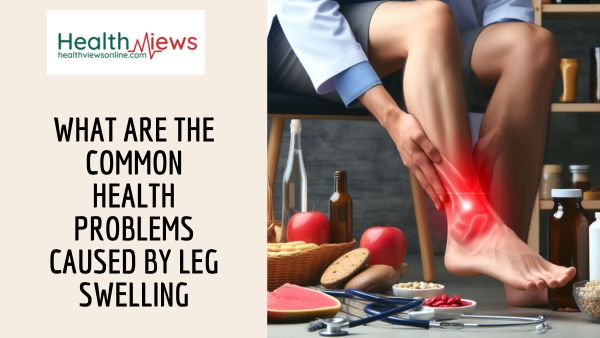Leg swelling, medically known as edema, is a prevalent and often worrying health condition that can present for a variety of reasons, affecting people of different ages and backgrounds. When extra fluid collects in the tissues of the legs, it causes obvious swelling, discomfort, and, in some circumstances, pain. In this article, we will look at the most common health problems caused by leg swelling, digging into the potential symptoms, and remedy techniques to help people better understand and deal with this common medical issue.
Recognizing the disorders that cause leg swelling is critical for early detection and proper care, resulting in improved leg health and general well-being.
Also, Read Restless Leg Syndrome RLS: Symptoms, Causes, Prevention, and Treatment
Top 10 Common Health Problems Caused by leg Swelling with Symptoms, prevention and Care Tips
1. Venous Insufficiency
Symptoms – Swollen, achy legs, especially after prolonged standing or sitting.
Prevention – Elevate your legs whenever feasible, wear compression stockings, and do leg exercises on a regular basis.
Care tips – Consult a vascular specialist for an evaluation and treatment options.
2. Deep Vein Thrombosis (DVT)
Symptoms – Swelling, pain, warmth, and redness in one leg.
Prevention – Maintain an active lifestyle, stay hydrated while traveling, and consider blood-thinning drugs if prescribed by a doctor.
Care tips – If you suspect DVT, get emergency medical assistance.
Also, watch health views web stories: How To Reduce Leg Swelling In Pregnancy
3. Heart Failure
Symptoms – Swelling in the legs and ankles, shortness of breath, fatigue.
Prevention – Manage underlying heart issues, eat a low-sodium diet, and take medications as advised.
Care tips – Monitor fluid intake regularly and visit a cardiologist for continued care.
4. Kidney Disease
Symptoms – Swelling, particularly in the lower legs and feet, along with changes in urination.
Prevention – Maintain a healthy blood pressure, remain hydrated, and eat a kidney-friendly diet.
Care tips – For kidney disease care, consult a nephrologist.
5. Lymphedema
Symptoms – Persistent leg swelling due to lymphatic system dysfunction.
Prevention – Avoid injuries and infections, use diligent skincare, and think about specialized lymphedema therapy.
Care tips – Work with a qualified lymphedema therapist for individualized therapy.
6. Cellulitis
Symptoms – Swelling, redness, irritation, warmth, and pain in the affected leg.
Prevention – Maintain good cleanliness, treat wounds promptly, and use adequate skin care.
Care tips – Seek prompt medical assistance and finish any medications prescribed for cellulitis.
7. Arthritis and Joint Disorders
Symptoms – Joint inflammation, pain, and swelling in the legs.
Prevention – Medication, physical therapy, and lifestyle changes can help you manage underlying joint issues.
Care tips – Consult a rheumatologist for proper management.
8. Peripheral Artery Disease (PAD)
Symptoms – Leg pain, cramping, and swelling, especially during physical activity.
Prevention – Quit smoking, live a heart-healthy lifestyle, and take your medications as prescribed.
Care tips – Consult a vascular specialist for an evaluation and possible interventions.
Also, Read Complete Guide About:12 Common Digestive Disorders (Part1)
9. Infections
Symptoms – Swelling, redness, and warmth in the affected leg, along with fever.
Prevention – Practice good hygiene, keep wounds clean and covered, and seek medical attention for infections.
Care tips – Follow the treatment strategy provided for the specific infection.
10. Medication Side Effects
Symptoms – Swelling in the legs as a side effect of certain medications.
Prevention – Discuss potential side effects with your healthcare provider, and consider alternative medications if needed.
Care tips – If you suspect medication-induced leg swelling, contact your doctor right away.
In conclusion, leg swelling, a common medical concern, can be indicative of various underlying health problems. These 10 common health problems caused by leg swelling encompass a broad spectrum of conditions, each with its own set of symptoms and treatment options. Recognizing these health issues is the first step in addressing the underlying causes of leg edema.
Leg swelling should not be neglected because it can have a substantial impact on a person’s well-being and quality of life. Individuals can better manage leg swelling and its associated issues by staying aware of these frequent health problems and adhering to proper care and prevention techniques, supporting better leg health and overall health.
Also, Watch health views web stories: 8 Best Home Remedies for Hemorrhoids





